NeuroDrez
Our flagship strategy game with PokerDrez cards and custom double figures for both Christian and Muslim sides.
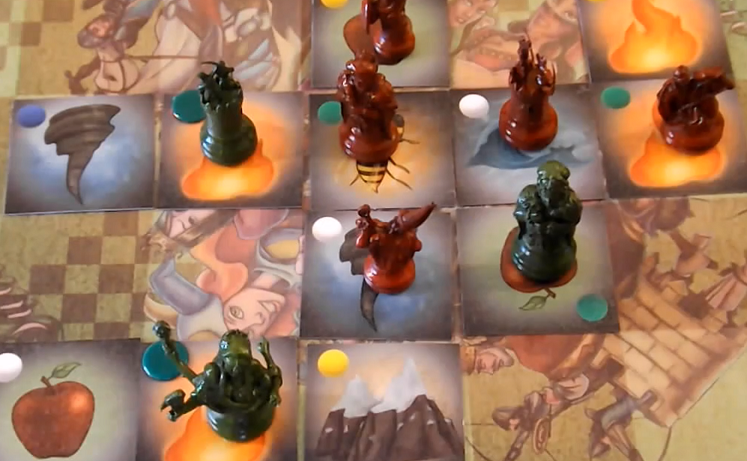
Content
- 1 PokerDrez deck (56 cards)
- 24 custom chess pieces (each with a Muslim and a Christian side) divided into 4 colors (red, green, blue, and yellow) of 6 figures each (King, Queen, Rook, Bishop, Knight, and Pawn)
- 36 square tiles: Each tile represents one of the six colors and one of the 6 natural resources or surfaces (earth, water, air, fire, flora, and fauna). Once placed on the board, they form the terrain where chess pieces can be positioned.
- One die with numbers one through six: corresponds to each of the Chess/Pokerdrez figures (Pawn:1, Knight:2, Bishop:3, Rook:4, Queen:5, and Joker:6; the king doesn’t need this).
- One die with the six colors: corresponds to the six colors of the tiles.
- One die with the six surfaces: corresponds to the six different surfaces of the tiles.
Round tokens in the 6 colors: Used to mark conquered tiles as your own. - 10 transparent tokens: Placed under each piece when played, they serve to limit the number of pieces that can be on the terrain at once.
- 7×7 board (reversible for use in PokerDrez as well).
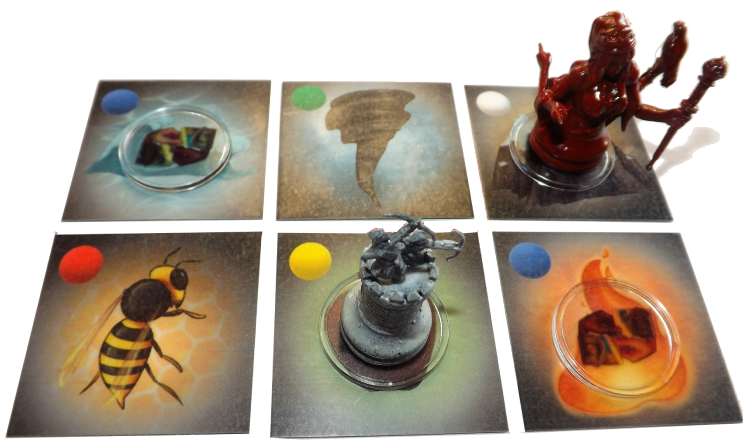
Players and cards
Two to four players can participate.
It can be played individually or in teams.
Each player will choose a color. Consequently, they will receive the chess pieces and round tokens of that color. In the case of two players, each can choose two colors as their own.
If there are 4 players, pairs must be formed, sitting alternately at the table and taking turns equally. It is allowed for pairs to discuss their moves aloud before making them or try to influence other pairs with their proposals.
Before distributing the tiles, 6 of them (one of each resource and color) will be placed in the center of the board.
The remaining tiles will be distributed equally among all players. Any leftovers (in the case of 4 players) will be added to those already on the terrain. Players should not reveal their cards to others until the moment of placing them on the terrain.
Each player will receive two PokerDrez cards, keeping them hidden from the others.
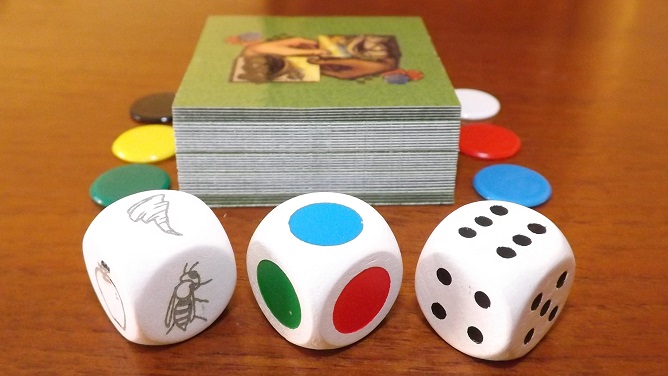
The dice
There are three dice (one for color, one for resources, and one numeric).
- With the color die, the player can move one of their pieces (inside or outside the terrain) to any area on the terrain of that color.
- With the resource die, the player can move one of their pieces (inside or outside the terrain) to any area on the terrain of that resource.
- The number rolled on the numeric die allows the player to move one of their pieces with that number (inside or outside the terrain). The number 6, corresponding to the Joker, allows moving any of the pieces. The possibilities of movement will be determined by the other two dice (both when entering the terrain and moving within it) or by the natural movements of the piece (as in traditional chess) once inside the terrain.
The two own cards
Alternatively to the numeric die, one of the two personal cards can be used to determine the piece that can be moved or entered into the terrain.
A Joker card (similar to the number 6 on the numeric die) will allow moving or entering any of the pieces onto the terrain.
The turns
The player who gets the highest number when rolling the numeric die will be the one to start the game. In case of a tie, the procedure will be repeated only among the winners until there is a single winner. The playing order will be established clockwise.
During their turn, the player must:
1. Place one of their tokens on a tile of a different color that they may have been conquering since a previous turn.
2. Roll the dice.
3. Place a new tile so that it always borders at least one side with one of the existing tiles.
4. Enter one of the pieces as indicated by the dice or move one of their pieces that is already inside as indicated by the dice or the natural movement of the piece.
The entry of the pieces
The player can choose any of their pieces to enter the terrain, as indicated by their cards or the numeric die.
The numeric die identifies the pieces as follows:
- 1: Pawn
- 2: Knight
- 3: Bishop
- 4: Rook
- 5: Queen
- 6: Joker (allows entering or moving any piece)
If the player decides to use one of their two cards to enter a piece corresponding to the terrain, they must show it to their opponents, discard it, and draw a new one from the deck that they can use in the next turn.
If the number 6 comes up on the die or a Joker card is used, any piece can be entered into the terrain; otherwise, the card or die number must match the chosen piece.
The king can always be entered, regardless of the die or cards held. There can only be one king per player or team on the terrain at a time. This process of entering the king is considered a move. The king cannot be moved twice consecutively (After entering or moving the king, another piece must be moved in another turn before the king can be moved again).
The piece to be entered can only be moved to one of the tiles of the color indicated by the color die or the surface indicated by the surface die.
Since the piece is placed after rolling the dice, a tile can be chosen to place it in a way that favors the entry of the piece.
Number of pieces on the terrain
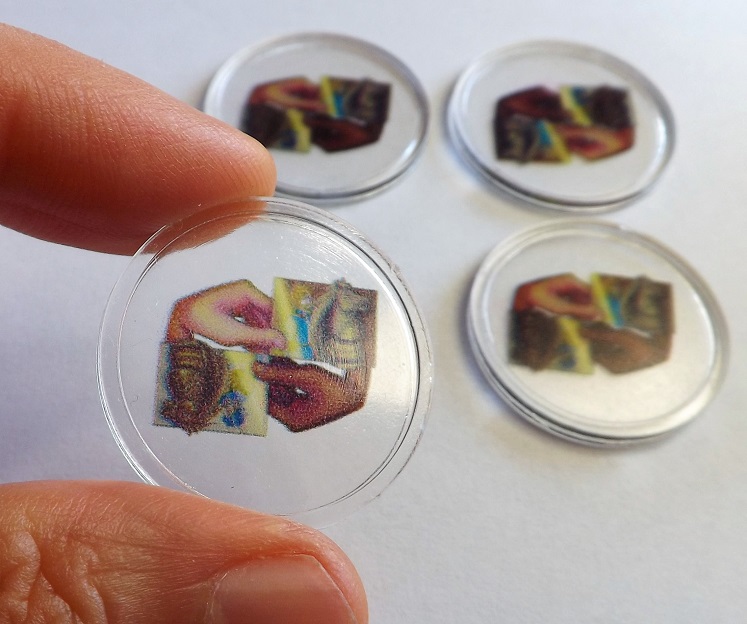
Transparent tokens will be used to limit the number of pieces per player/team that can coexist on the terrain:
- In the case of two players/teams: 5
- In the case of three players: 3
When these limits are reached, the player/team cannot enter any other pieces onto the terrain until one of the pieces on it is captured by one of their opponents.
The captured pieces will be returned to their owner, and they can re-enter them onto the terrain during their turn under the same conditions as the first time.
Piece movement on the terrain
Once the piece is on the terrain, it can be moved whenever the numeric die or one of the two personal cards allows it.
The rules for determining which piece can be moved on the terrain are the same as those for determining which piece can enter it.
Once the piece on the terrain to be moved is clear, it can be moved according to the following criteria:
- To any tile of the color indicated by the color die.
- To any tile of the surface indicated by the surface die.
- To any tile it can reach based on its natural movement defined by the type of piece:
Pawn: It can move to any tile horizontally or vertically (like the rook in chess) but can only capture opposing pieces located on one of the four diagonally adjacent tiles coinciding with one of its vertices.
Knight: Moves and captures as in chess (in an L-shape), jumping over other pieces if necessary.
Bishop: Moves and captures as in chess (diagonally), but can also move (not capture) to one of the 4 horizontally or vertically adjacent positions to its current position (left, right, up, or down). It cannot jump over other pieces or empty tiles.
Rook: Moves and captures as in chess (horizontally and vertically). It cannot jump over other pieces or empty tiles.
Queen: Moves and captures as in chess (horizontally, vertically, and diagonally). It cannot jump over other pieces or empty tiles.
King: Moves and captures as in chess (horizontally, vertically, and diagonally, but only to tiles in contact with its own).
If a player cannot enter or move any pieces, he will have to remove one from those on the terrain. In this case, the player will show his two cards to the other players to demonstrate that he has no valid moves with his pieces, and then replace them with two new cards from the deck that can be used in future moves.
Own and opponent's tiles
Tiles have their own color, represented by a circle in the upper left corner.
When a piece is placed on a tile of a different color, it begins to conquer it.
While conquering a tile, a piece can be captured by another piece on the same tile.
A captured piece is removed from the board but can re-enter it in a later turn.
If a piece manages to stay on an opponent’s tile for an entire round (until it’s the same player/team’s turn again), it has conquered the tile.
To demonstrate ownership, the player will place a token of the piece’s color over the original circle on the tile, covering it.
If the player passes the dice to the next player (indicating the end of his turn) without placing his token on a tile he could have been conquering, that position remains unconquered (and the piece remains vulnerable to capture).
A conquered tile can be reconquered, either by its original owner or by any other player.
When a piece is on a tile of its own color (original or conquered), it is in a safe position and cannot be captured.
When one of the players (or teams) dominates all six tiles (original or conquered) of a particular surface with their colors, they win the game.
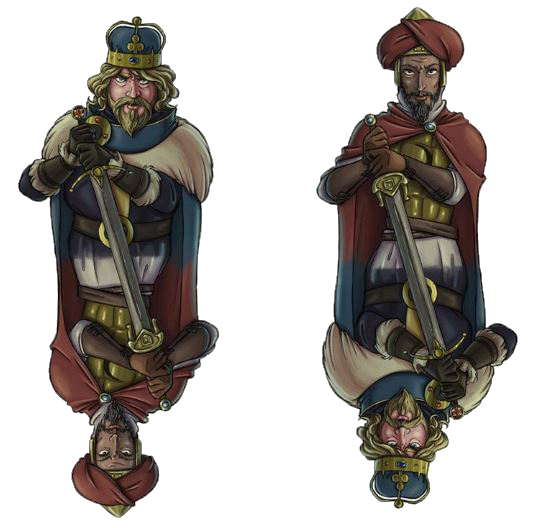
Sudden death
Once the 36 tiles are placed, they will begin to be removed by players (one per turn, after rolling the dice and before moving the piece).
Only tiles located on the edge of the terrain can be removed (at least one of their sides must be free and have communication with the outside).
Tiles with a piece on them cannot be removed (regardless of the tile and piece color).
The last tile connecting two parts of the terrain cannot be removed. After removing a tile, the remaining tiles on the terrain cannot be separated into two distinct groups.
Removing a tile on their turn is mandatory for all players if there is a tile for which its removal is allowed, even if it doesn’t benefit the player.
If none of the tiles can be removed according to the rules above, the player will skip this step during his turn but must continue his turn by moving or entering one of his pieces.
During this phase, the game will be won by the player/team that has managed to conquer with their colors all the tiles remaining on the terrain of any surface.
Sudden early death
If participants enjoy analyzing all the variations in each play, the game can be extended.
When time is limited, the alternative of anticipating sudden death, even before all the initial tiles have been placed, can be used.
This circumstance can be requested by any participant, provided that at least half of the tiles have already been placed, i.e., 18 or more.
The first player to start removing tiles will be the one to the right of the one who requested the early sudden death.
Taking this peculiarity into account, it is always a good strategy to keep all 6 resources under control at all times to avoid being caught off guard by an opponent who wants to take advantage of a favorable circumstance on the board.
Collaborative and solitary mode
In the collaborative mode, players or teams must try to conquer a different resource each, but they will only win if they achieve it during the same turn. That means after a player or team conquers all the tiles of one resource, the other team must conquer one of the other resources in the immediately following turn.
In solo mode, the player represents all 4 colors separately and must organize everything so that each color conquers one of the resources during the same final turn.
Strategy
Tile Placement:
Similar to Dominoes, having more tiles of a specific resource allows placing them at specific moments and positions where it is easier to conquer them.
Surrounding one’s own tiles with others helps protect them, making it more difficult to remove them later during sudden death.
Tiles of opponents’ colors can be reserved to be placed in the final moves before sudden death. This way, they will be on the edge of the terrain, making it easier to remove them without having to conquer them. Additionally, this reduces the chances of opponents occupying them in a safe position.
Placing tiles in certain positions can complete straight lines and allow certain pieces (like the bishop, rook, or queen) to reach more distant positions. Removing specific tiles during sudden death may have the opposite effect.
Entering the Terrain:
Normally, it is better to enter a piece into the terrain than to move one that is already inside. This increases the number of pieces on the terrain that can move according to their natural movement.
It is better to enter more powerful pieces (with more movement possibilities on the terrain). If they are captured, they can always be entered again in a later turn.
Conquering Tiles:
There are more chances of conquering tiles when they cannot be reached by enemy pieces through their natural movement.
One should try to conquer positions that can be reached with their natural movement by other own pieces. This way, if the opponent manages to capture our piece, there are more chances of recapturing the position.
It is better to conquer a square from an opponent than a neutral square (one of a color that belongs to no one) because it removes an already conquered zone (in addition to adding it later as our own).
Capturing Pieces:
Whenever possible, capturing an opponent’s piece should be done (although it is not mandatory) because it removes the piece from the terrain (so it can no longer use its natural movements) and prevents it from conquering a zone.
Sudden Death:
One should try to reach sudden death with one’s own piece on a tile of as many existing resources as possible to prevent others from easily removing them.
By removing the appropriate tile, we can prevent any of our opponents from removing the one that remains connecting two parts of the map, as this is not allowed.
In this sudden death stage, one must think carefully not only about one’s own moves but also about the moves of the following players because the game could end in a single turn if the players finish conquering a position and then remove the last tile from the map, which still did not belong to them, of a specific resource.

